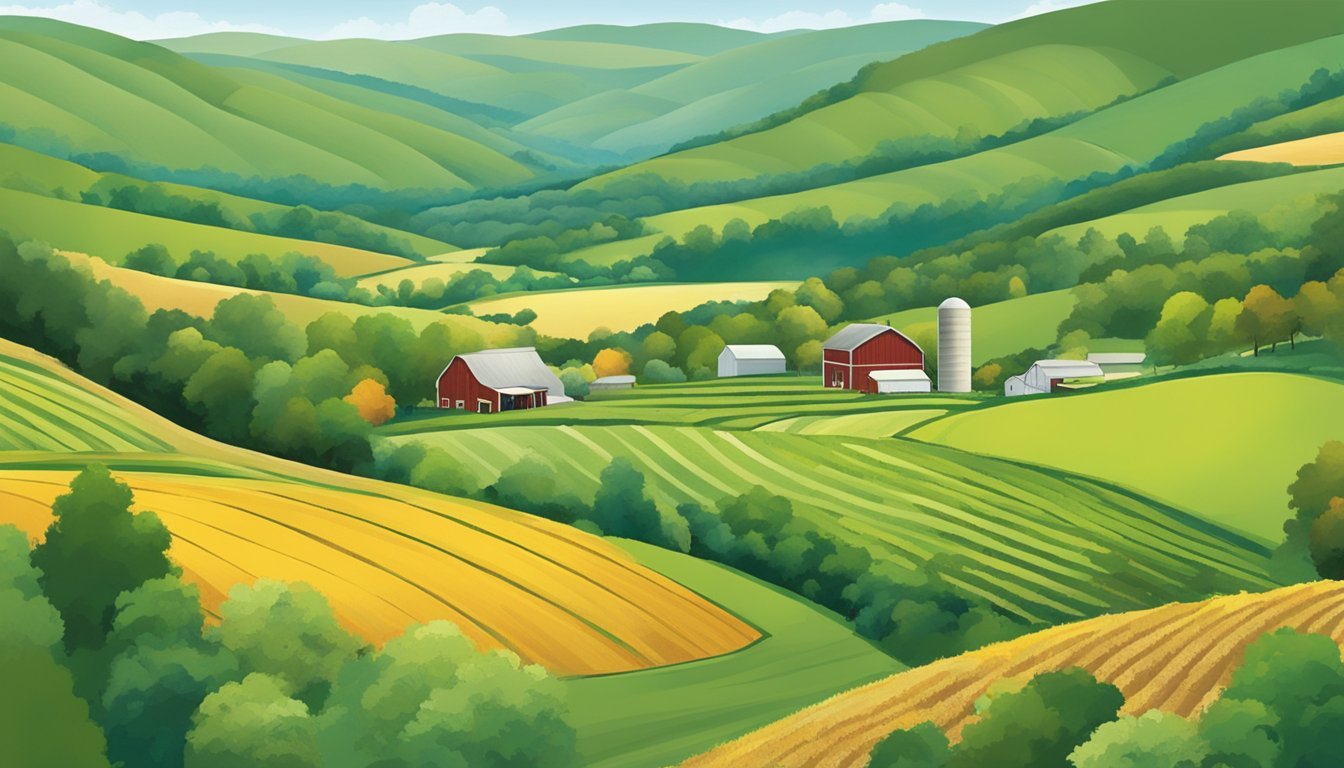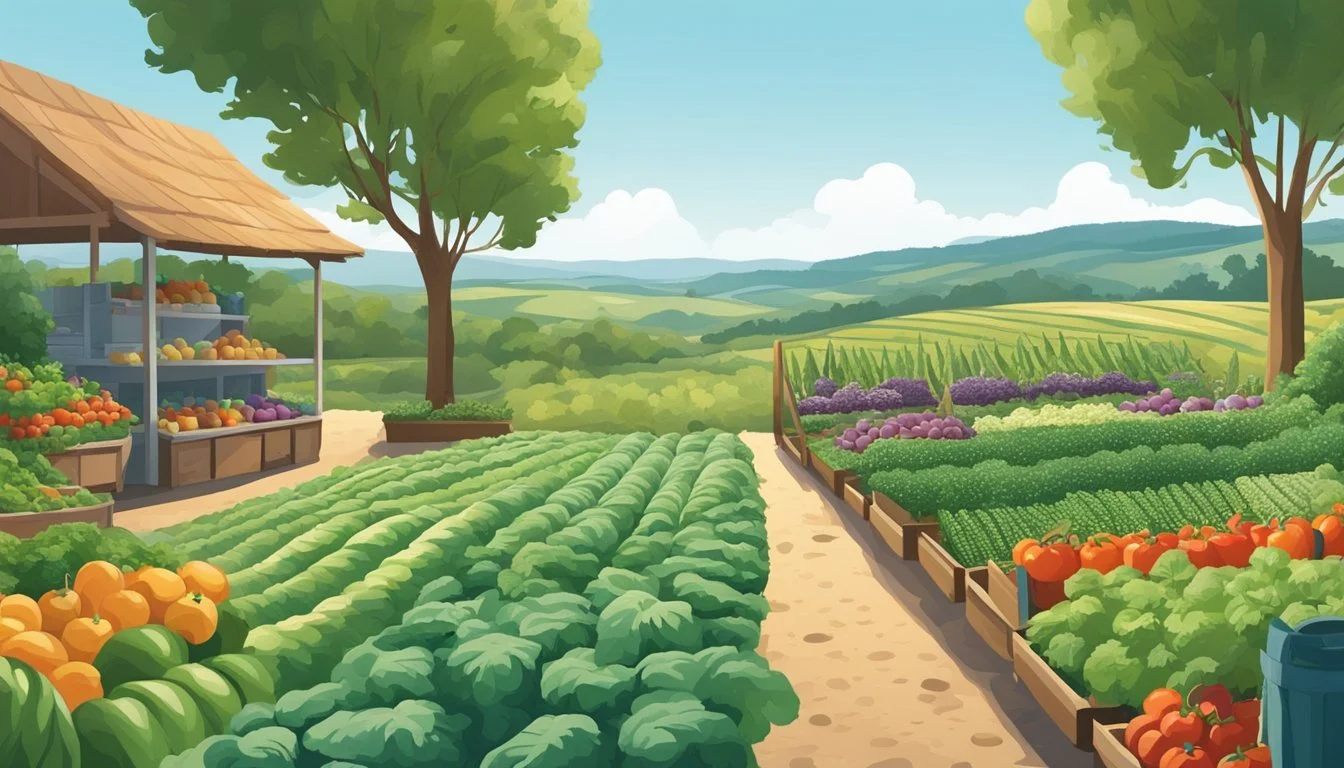Guide to Farming in West Virginia
Essential Tips for Successful Agriculture
This Article is Part of Our State by State Farming Guide
West Virginia, with its varied topography and climate, offers a rich and diverse terrain for agricultural pursuits. Farming in the Mountain State has traditionally been a cornerstone of the local economy and culture, reflecting a legacy of resilience and community. Present-day agricultural practices in the state are an amalgamation of this heritage and modern advancements, accommodating a range of activities from traditional in-ground farming to innovative container gardening. With an emphasis on sustainable growth, West Virginia's agricultural sector continues to explore and expand its capabilities.
Agriculture in West Virginia is not confined to large expanses of land but can also be achieved through small-scale operations such as beekeeping, agribusiness, and home gardening, which contribute to local food systems and the overall agricultural economy. The state provides support and resources for new and established farmers through various programs tailored to their needs, addressing the intricacies of farming in the distinct Appalachian environment. Resources and assistance cover critical aspects of farm management, including crop selection, land use strategies, and navigating the economic landscape of agriculture in West Virginia.
The state's agricultural advisory board actively develops strategic plans to further enhance farming's potential, with the recognition that agriculture and small farms are essential to the economic and social fabric of West Virginia. The shared goal among stakeholders is a thriving, sustainable agricultural sector that not only supports West Virginia's economy but also fosters a strong sense of community within its populace.
History and Background of West Virginia Farming
West Virginia's rich agricultural tradition can be traced back to its early settlers, evolving through the centuries to adapt to both the state’s topography and changing market demands. Today, it continues to be an essential industry that shapes the Mountain State's economy and cultural heritage.
Early Setters and Agricultural Development
The roots of agriculture in West Virginia stem from the activities of Native Americans and early European settlers, who farmed the land to sustain their communities. Post-Civil War, agriculture flourished with the state’s attainment of statehood. The number of farms grew dramatically, reaching 40,000 by 1869, covering 8.6 million acres. This growth trend continued into the late 19th century, despite the obstacles presented by the state’s mountainous terrain.
1869: 40,000 farms
Acreage: 8.6 million acres
Modern Farming and Industry Evolution
By the 20th century, West Virginia's farming industry began to experience shifts in demographics and economics. Urban migration started to draw people away from rural farming areas. However, by the 2012 Agricultural Census, there were still 21,480 farms with an average size of 209 acres, illustrating a significant presence of small farms. Today, these small farms are a vital part of the state's agriculture, contributing to nearly 29 percent of the state's total farm sales. West Virginia's agriculture has seen diversification over the years, with farmers producing a wide variety of products, from traditional crops to livestock, reflecting the industry's adaptation to modern demands.
2012: 21,480 farms
Average farm size: 209 acres
Small farms: Represent 29% of total sales
Through historical challenges and advancements, agriculture remains a cornerstone of West Virginia’s identity and economy, signifying the resilience and adaptive spirit of its people.
Understanding West Virginia's Climate and Soil
In West Virginia, farming is significantly influenced by the state's diverse climate and soil characteristics. To optimize agricultural practices, a thorough understanding of these elements is essential.
Regional Variations in Climate
West Virginia's climate demonstrates considerable regional variation due to its topography, which ranges from high mountain ridges to low river valleys. The Eastern Panhandle and lowland areas experience warmer temperatures, conducive to a longer growing season. In contrast, the Appalachian Mountains bring cooler temperatures and a shorter growing cycle. This variation directly affects crop selection and planting schedules.
Precipitation is typically abundant, providing sufficient water for crops, but farmers must plan for the variability in weather patterns which can include droughts or floods. Sunlight, a critical factor for crop photosynthesis, may also vary with the topography, demanding strategic placement of crops to maximize exposure.
Soil Types and Composition
West Virginia's soil is as varied as its climate. The U.S. Department of Agriculture and West Virginia University (WVU) Extension service classify several soil types across the state, each with its unique characteristics and potential for agriculture. For instance:
Monongahela Silt Loam: Present in Northern West Virginia, these soils are deep and well-drained, ideal for hay and pastureland.
Gilpin Silt Loam: Found on upland ridges, this type has moderate drainage and is suited to timber and certain types of grasses.
Dekalb Silt Loam: Often seen in the central regions, this soil is less fertile and requires careful management for productive agriculture.
The soil's organic matter content, water-holding capacity, pH level, and mineral composition are factors farmers consider when managing soils for improved yield. WVU Extension provides resources for best practices in soil management to enhance fertility and productivity. On the other hand, soil conservation efforts by the state, including the Natural Resources Conservation Service, assist farmers in preserving soil integrity.
To thrive in West Virginia's agriculture, farmers rely on understanding and adapting to these detailed climate and soil conditions.
Selecting the Right Crops
Choosing the appropriate crops for cultivation in West Virginia involves considering the state's distinct seasons and soil adaptability. Farmers need to differentiate between warm-season and cool-season crops and understand native plant compatibility to ensure a successful harvest.
Warm-Season and Cool-Season Crops
Warm-Season Crops: These crops thrive in the warm summer months of West Virginia. They are typically planted after the last spring frost and require both warm soil and high temperatures for proper growth. Examples include:
Tomatoes: Best sown after the danger of frost has passed, generally around May 12th to October 15th.
Corn: Prefers warm conditions and should be planted in well-draining soil after the last frost.
Cool-Season Crops: Contrary to warm-season varieties, cool-season crops can withstand West Virginia's cooler spring and fall temperatures. They often thrive when planted early in the season or towards the late summer for a fall harvest. For instance:
Potatoes: They can tolerate light frosts and are often planted in early spring.
Soybeans: (how long do soybeans last?) Known for their cold hardiness, they can be grown longer and may allow for multiple harvests within the year.
Native Plants and Crop Suitability
West Virginia farmers benefit from incorporating native plants and understanding each crop's suitability to the local environment. Soil quality, topography, and climate play significant roles in determining the best crops to grow.
Native Plants: Favoring native species supports local ecosystems and can offer more resilience to pests and diseases.
Vegetables: A wide selection of vegetables can prosper in West Virginia's varying climate, from leafy greens and root vegetables in the cooler months to peppers and squash in the warmer season.
By paying close attention to these factors, farmers can select crops that are not only adapted to West Virginia's diverse climate but also have the potential for higher yields and profitability.
Organic Farming Techniques
In West Virginia, organic farming techniques prioritize maintaining ecological balance and preserving biodiversity, focusing specifically on soil quality and holistic pest and disease management.
Soil Fertility and Crop Rotation
Soil fertility is the cornerstone of successful organic farming, with emphasis on the addition of organic matter to enrich the soil. Farmers often incorporate green manures, compost, and animal manures to increase the nutrient content, which can include phosphorus, potassium, and other essential minerals. They use cover crops to protect the soil from erosion and to add organic matter back into the ground.
In terms of crop rotation, a planned sequence of crops is used to prevent depleting soil nutrients. This practice breaks pest and disease cycles, and it contributes to the soil's health by alternating deep-rooted and shallow-rooted plants. Here is an example of a simple crop rotation plan:
Year 1: Legumes (fix nitrogen)
Year 2: Leafy greens (use nitrogen)
Year 3: Root crops (build soil structure)
Year 4: Fruit-bearing vegetables (heavy feeders)
Farmers may apply lime to regulate soil pH and ensure optimal nutrient availability for crops.
Pest and Disease Management
For pest management, organic farmers rely on natural predators and beneficial insects instead of synthetic chemicals. They cultivate an environment that encourages beneficial insects that prey on unwanted pests. Farmers may also use insect traps and barriers as physical controls. Regular crop inspections help to identify and manage issues early.
Regarding disease management, prevention is paramount. This involves crop rotation, resistant plant varieties, and proper spacing to improve air circulation, which reduces the risk of fungal diseases. When diseases are detected, organic-approved sprays may be gently applied, though these are considered a last resort.
Organic farmers in West Virginia are also known to integrate animals into their farm ecosystem, which helps manage pests and cycles nutrients through their systems. They continually educate themselves on the most current organic farming practices to enhance their farm’s productivity and sustainability.
Animal Husbandry in West Virginia
West Virginia's diverse topography, encompassing cool mountains and fertile valleys, provides a conducive environment for animal husbandry. The state demonstrates a robust investment in quality assurance and education for livestock management across various species.
Cattle and Dairy Production
Cattle farming is a significant part of West Virginia's agriculture sector, with a focus on both beef and milk production. Beef cattle are raised across the state, benefiting from the pastureland available in the region. Dairy farming also contributes to the agricultural output, with farmers emphasizing sustainable practices to produce milk and dairy products.
Beef Cattle:
Primary focus on quality meat production
Requires completion of quality assurance programs for better management practices
Dairy Cattle:
Farms operate with a focus on sustainability
Continuous efforts to enhance milk quality
Poultry and Small Livestock Management
Poultry farming, including chickens for meat and egg production, is an integral part of West Virginia's livestock industry. Small livestock such as sheep, goats, and rabbits are also managed for their meat and breeding attributes.
Poultry:
Emphasis on breeding for both meat and eggs
Quality assurance programs in place to improve management
Small Livestock:
Sheep and goat farming includes meat and breeding programs
Free flock ID tags are offered to help in disease prevention and control
In conclusion, West Virginia supports a multifaceted animal husbandry sector, with education and quality assurance playing critical roles in its success.
Gardening for Home and Market
In West Virginia, both novice and experienced gardeners can successfully cultivate a vegetable garden for home use or sales at local markets. Understanding the best practices for starting a garden and the nuances of harvesting and marketing can yield substantial benefits.
Starting a Vegetable Garden
Site Selection and Preparation: Choosing a site with adequate sunlight, good drainage, and access to water is crucial. One should prepare the soil by incorporating organic matter and ensuring a pH suitable for vegetables like spinach, carrots, and onions.
Planning and Planting: A well-planned vegetable garden maximizes space and crop productivity. One can use raised beds or in-ground planting methods. Crop rotation and companion planting can enhance soil health and reduce pests.
Best Planting Times: Refer to the West Virginia vegetable planting guide for optimal planting windows.
Selection of Vegetables: Favor peppers and other crops that thrive in West Virginia’s climate.
Spacing: Follow recommended spacing guidelines to prevent overcrowding and promote healthy growth.
Harvesting and Selling Produce
Proper Harvesting: Timely harvesting ensures peak flavor and nutrition. One should harvest in the morning when temperatures are cool to maintain freshness.
Marketing: Selling produce at farmers markets and to local food establishments can be profitable.
Regulations: Familiarize oneself with local regulations regarding the sale of homegrown food.
Presentation: Attractive presentation and consistent quality can establish a loyal customer base at local markets.
Pricing: Competitive pricing aligned with the local market standard is key to a successful venture.
Initiating a vegetable garden in West Virginia requires careful planning and adherence to best practices from site selection to selling the harvest. Home gardeners and small farmers can contribute to local food systems and engage profitably with markets by following seasonal guidelines and maintaining high-quality standards in their produce.
Farm Business Management
In West Virginia, the success of farm businesses hinges on understanding the local market dynamics and effective economic planning based on farm size. These two aspects are critical in ensuring that the farms, whether small-scale or large-scale, are profitable and sustainable.
Understanding Local Markets and Distribution
West Virginia’s agribusiness landscape is characterized by a diverse mix of small farms and larger agricultural enterprises. Small farm owners can capitalize on their unique position by catering to local markets where they can sell directly to consumers, such as at farmers' markets. These direct sales allow for a closer connection with the customer base and provide immediate feedback and market intelligence that can be crucial for business adjustments.
To navigate these local markets successfully, farmers must:
Identify local demand for various products.
Understand distribution channels, including farmers markets, Community Supported Agriculture (CSA) programs, local grocery stores, and restaurants.
Establish relationships with local businesses and consumers.
Stay informed of trends and adapt their offerings accordingly.
Farm Size and Economic Planning
Economic planning is essential for farm sustainability, with farm size playing a pivotal role in determining the suitable business model. In West Virginia, both large-scale poultry farms and budding small farms contribute to the economy and require different management strategies.
When considering farm size and economic planning, farmers should:
Conduct a thorough market analysis to project potential income.
Develop a comprehensive business plan that includes financial projections and risk management strategies.
Utilize tools like performance indicators to guide business goals and resource allocation.
Continually assess the efficiency of their operations to improve profitability.
Farmers in West Virginia must adapt their strategies based on their scale of operations, available resources, and the industry's landscape to thrive in the competitive field of agribusiness.
Sustainability and Resource Management
In West Virginia, sustainable farming practices are pivotal to conserving resources and managing the agricultural landscape effectively. Farmers prioritize water conservation and the maintenance of biodiversity within ecosystems to ensure long-term productivity and environmental health.
Water Conservation and Management
Water conservation is crucial in West Virginia's agricultural strategy. Farmers implement various methods to reduce water waste and promote efficient usage. Techniques include:
Drip irrigation systems: These target the root zones of crops directly, minimizing evaporation and runoff.
Rainwater harvesting: Collecting rainwater reduces reliance on local water bodies and provides a sustainable water source during dry periods.
Soil moisture monitoring: Advanced sensors can help farmers understand when to water, optimizing usage.
Additionally, agricultural extension services in West Virginia provide guidance on integrating these methods into farming operations.
Maintaining Biodiversity and Ecosystems
The health of West Virginia's farmland is deeply intertwined with its biodiversity. A variety of species contributes to a robust ecosystem, which supports sustainable agriculture by:
Pollination: Biodiversity includes critical pollinators like bees, which are essential for the reproduction of many crops.
Soil fertility: A diverse range of organisms contributes to nutrient-rich soil, reducing the need for synthetic fertilizers.
Farmers foster biodiversity through practices like:
Crop rotation: Alternating crops can prevent pests and diseases, reducing the need for chemical inputs.
Habitat creation: Establishing buffer zones and maintaining natural habitats encourages wildlife to thrive alongside agricultural areas.
These strategies not only protect the current ecosystem but also preserve it for future generations.
Additional Resources and Support
West Virginia's agricultural community has access to a robust network of support structures aimed at fostering growth and sustainability. Resources available to farmers range from technical assistance and educational programs to financial aid that can help enhance productivity and manage farmland effectively.
West Virginia Department of Agriculture Services
The West Virginia Department of Agriculture (WVDA) offers a spectrum of services designed to promote agricultural prosperity. With a commitment to bolstering the state's economy through farming, the WVDA provides:
Technical Assistance: Guidance on a range of issues, including water management and erosion control.
Financial Assistance: Programs like the Agricultural Management Assistance (AMA) promote conservation practices in farming.
Market Development: Initiatives to help farmers market their produce more effectively.
Regulatory Assistance: Ensuring compliance with agricultural regulations to protect both the producer and consumer.
Local county offices serve as the frontline for farmers to access these services, making it easier to receive support directly within their communities.
WVU Extension and Education Programs
The West Virginia University Davis College of Agriculture, Natural Resources, and Design, through its Extension Service, plays a key role in extending educational resources to the agricultural community. The College focuses on providing:
Educational Workshops: Training programs and seminars for skill enhancement and sharing of best practices.
Technical Resources: Access to the latest research and development in agricultural methodologies.
Youth Development: Programs such as 4-H to engage and educate the next generation of farmers.
The collaboration between WVU Extension and local farmers ensures a constant transfer of knowledge, preparing West Virginian agriculture to adapt and thrive in both current and future markets.
Appendix: Recommended Crop List
West Virginia’s diverse climate allows for a broad spectrum of agricultural products. Below is a list of recommended crops that thrive in the region, categorized for easy reference.
Vegetables:
Leafy Greens: Lettuce, kale, and Swiss chard grow well in West Virginia, particularly in the cooler months, benefiting from the state's mild temperatures.
Root Vegetables: Radishes, turnips, and beets are suited to the local soil conditions. They have relatively short growing seasons and can be planted at intervals for a continuous harvest.
Cruciferous Vegetables: Broccoli and cabbage are staple crops in West Virginia, known for their cold tolerance and grown effectively in fall.
Legumes:
Green beans and peas are favorable selections for West Virginia gardens. These crops fix nitrogen in the soil, reducing the need for additional fertilization.
Fruiting Vegetables:
Varieties such as cucumbers, zucchini, squash, and eggplant perform well in West Virginia's warm summers. They require full sun and well-drained soil.
Melons:
Watermelons and cantaloupes (how long does cantaloupe last?) need a longer growing season and should be planted after the last frost to ensure a sweet and ripe harvest.
Tree Fruit:
Apples: West Virginia's state fruit, the apple, requires a specific number of chill hours, readily provided by the state's climate. The fruit takes four to five years to bear fruit after planting.
For an effective and productive garden, West Virginia farmers should consider these crops carefully. They should account for local planting zones, sunlight exposure, and water access to ensure the best possible yields.
Appendix: Seasonal Farming Calendar
West Virginia's climate establishes a unique farming calendar, especially given its varying planting zones ranging from 5a to 7a. Farmers and gardeners must consider both the growing season and the specific zones when planning their planting schedules.
Spring:
March to April: Gardeners start indoor seedlings for vegetables like tomatoes and peppers.
Late April to May: Planting of hardy vegetables such as peas, spinach, and kale outdoors.
Summer:
June: Transition to planting warm-season crops, including beans, corn, squash, and cucumbers after the last frost.
July: Maintenance is critical for pest control, watering, and weeding to ensure healthy plant growth.
Fall:
August to September: Begin planting fall crops like turnips and lettuce, while harvesting early summer plantings.
October: Garlic can be planted for the next year, and fall vegetables like pumpkins are harvested.
Winter:
November to February: Time for planning next year's crops, ordering seeds, and repairing equipment. Some cold-hardy greens can be grown in hoop houses or under row covers.
Planting Zones:
Zone 5a: Coldest; shortened growing season.
Zone 6a/6b: Moderate; suitable for a diverse range of plants.
Zone 7a: Warmest; longer growing season, allowing for an extended planting calendar.
Farmers must adjust these guidelines to local conditions and monitor for last and first frost dates to ensure crop success.
Glossary of Terms
Agricultural Economics: A field of economics concerned with the application of economic theory in optimizing the production and distribution of food and fiber.
Farmers' Market: A place where multiple vendors come together to sell farm and food products directly to consumers at a fixed location.
Farm Stand: A retail outlet stationed on a farm where a producer sells farm and food products directly to consumers.
Right-to-Farm Law: Legislation aimed at protecting agricultural operations from urban encroachment and nuisance lawsuits, ensuring that farmers can conduct their business without undue interference.
Term Definition Agricultural Operations The daily activities and necessary practices for the cultivation and production of farm products. Farmland Land dedicated to agricultural purposes, including the cultivation of crops and rearing of livestock. Traditional Market A farmers' market where vendors sell goods in person at a communal space, typically open-air or indoor public spaces. Online Farmers Market A digital platform where multiple vendors can collectively market and sell their farm and food products. Right-to-Farm A legal principle that protects farmers from certain types of nuisance complaints and municipal regulations.
Extension Specialist: An expert affiliated with a university extension program who provides education and guidance in a specific field, such as agricultural economics.
Note: The size of farms and the amount of farmland can change due to various economic and environmental factors, and these changes can impact the agricultural landscape of regions such as West Virginia.
References
For those seeking detailed information on starting or operating a farmers market in West Virginia, the West Virginia Farmers Market Vendor Guide provided by the West Virginia Department of Agriculture is an essential resource. It offers clarity on regulations and best practices for farmers market vendors.
The guide to "Growing West Virginia's Agricultural Economy" illuminates the historical and current significance of agriculture and small farms in the state's economic landscape, highlighting traditional and emergent agricultural activities.
The West Virginia Department of Agriculture's Publications division issues informative booklets on diverse topics ranging from beekeeping and gardening to cooking and canning, which can be beneficial for aspiring and current farmers.
For compliance and registration information pertinent to all farmers markets in West Virginia, referencing the West Virginia Farmers Market Vendor Guide is recommended, as markets are required to register annually with the West Virginia Department of Agriculture.
Finally, West Virginia University's Extension Service offers resources tailored to beginning farmers, including guidance in agricultural economics and providing support systems through education aimed at enhancing farming operations within West Virginia.
These references serve as foundational materials for individuals seeking to understand and engage with the farming community in West Virginia.











